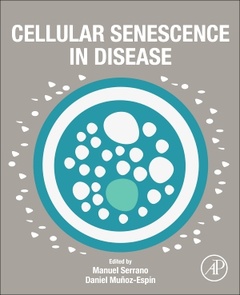Description
Cellular Senescence in Disease
Coordinators: Serrano Manuel, Munoz-Espin Daniel
Language: English
Subject for Cellular Senescence in Disease:
Keywords
Acute rejection; Adipose tissue; Ageing; Aging; Alzheimer disease (AD)Immune clearance; Atherosclerosis; Biomaterials; BMPR2Bone morphogenic protein receptor 2DDR; Bone loss; Carcinogenesis; Cartilage; Cell cycle arrest; Cellular senescence; Chondrocyte; Chondrogenesis; Chronic bronchitis; Chronic kidney disease; COPD; Degenerative diseases; Diabetes; DNA damage response; Donor age; Donor tissue quality; ECM; Emphysema; Extracellular matrix; Fibrosis; Fractures; Frailty; Hypoxia; IL-17IL-4IL-6Immunity; Inflammation; Interleukin 17Interleukin 4Interleukin 6IPFP; Interstitial lung; Ischemia-reperfusion injury; Kidney transplantation; Liver disease; Liver failure; Maladaptive repair; Mitotic versus postmitotic senescence; NAFLD; NASH; Navitoclax; Obesity; Oncogene; Oncogene-induced senescence; OPN; Osteoarthritis; Osteophyte; Osteopontin; Osteoporosis; p16p21p53SASP; PAH; Pancreatic beta cells; Pap; Parkinson disease (PD)Senescence-associated secretory phenotype (SASP)Senescent glia; PASMC; PEC; PH; Precancerous; Premalignant; Preneoplastic; Pulmonary artery hypertension; Pulmonary artery pressure; Pulmonary artery smooth muscle cells; Pulmonary hypertension; Pulmonary vascular endothelial cells; Regeneration; SASP; Senescence; Senescence-associated secretory phenotype; Senolysis; Senolytic therapy; Senolytic; Senolytics; Senomorphics; Senotherapy; Synovitis; Synovium; Telomere; TGF beta; Tissue repair; Transient versus chronic senescence; Transplant-related injuries; Tubular atrophy; Tubular cell senescence; Tubulointerstitial fibrosis; Tumor suppression; Type 1 diabetes; UBX0101
472 p. · 19x23.4 cm · Paperback
Description
/li>Contents
/li>Biography
/li>Comment
/li>
Winner of the 2023 PROSE award in Biomedicine and Neuroscience!
Research in the field of senescence has boomed recently due to the gradual realization that senescent cells are associated with a significant number of diseases. The genetic or pharmacological elimination of senescent cells can cause widespread benefits and improves outcomes for most of those diseases. Cellular Senescence in Diseases presents an updated review of the role of cellular senescence in multiple pathologies. Focus is given to those diseases where the implication of senescence has been more extensively documented, such as (cancer, lung and liver diseases, diabetes, Neurodegenerative diseases and others).
The Editors recruited a group of worldwide experts in each individual pathology to review the role of cellular senescence in each one of them, aiming at identifying potential therapeutic pathways. The first two chapters provide an overview of the cellular senescence principles. Next, the chapters are divided into specific diseases. Cancer, including premalignant lesions (OIS), Advanced disease (TIS), and Metastasis are covered. The following condition covered is Lung diseases, including IPF, COPD, and Pulmonary Hypertension. Next Liver Diseases are covered, including Fibrosis and Cirrhosis, and Fatty liver disease. Next there is coverage for Kidney implications, including fibrosis and transplantation. Vascular diseases are covered next including infarction and hear fibrosis, and atherosclerosis. Both diabetes types 1 and 2 are covered next. Following chapters cover Obesity, Sarcopenia, and Bone and Cartilage disorders, respectively. Neurodegenerative diseases are covered next, focusing on Alzheimer's and Parkinson's. The next chapter discusses accumulation of senescent cell in tissues during aging. The two final chapters cover current developments and conclusions.
Cellular Senescence in Diseases is designed for researchers and clinicians with a focus on the cellular mechanisms of diseases. All chapters cover current experimental therapeutic approaches to eliminate or cancel the pathological effects of senescent cells. Pharmaceutical scientists may also benefit from the contents of the book in the exploration of novel therapeutic opportunities.
I. Fundamentals 1. Introduction to Cellular Senescence 2. Cellular and Molecular aspects
II. Cellular Senescence in Disease States 3. Cancer 4. Lung diseases 5. Liver diseases 6. Kidney diseases 7. Vascular diseases 8. Diabetes 9. Obesity 10. Sarcopenia 11. Bone and Cartilage Disorders 12. Neurodegenerative diseases 13. Accumulation of senescent cells in tissues during Aging
III. Conclusions 14. Current developments - where research is going 15. Conclusions
The main contributions of Dr. Serrano’s lab during these years are related to the concept of oncogene-induced senescence and the anti-ageing activity of tumor suppressors. More recently, his group has reported on the relevance of tumor suppressors in metabolic syndrome, the existence of senescence during embryonic development, and the feasibility of embryonic reprogramming within living adult organisms (the latter was considered "Achievement of the Year 2013" in the stem cells field by Nature Medicine).
Dr. Daniel Munoz-Espin is Senior Research Associate at the Department of Oncology of the University of Cambridge. His lab is part of the CRUK Cambridge Centre Early Detection Programme, working at interface between cellular senescence, plasticity and the fundamental processes and mechanisms that lie at the origin of cancer. We are also developing novel tools and nanodevices for cancer therapy and diagnosis.
- 2023 PROSE Awards - Winner: Category: Biomedicine and Neuroscience: Association of American Publishers
- Provides a thorough introduction to Cellular Senescence
- Covers all major pathologies for which cellular senescence has shown evidence of involvement
- Focuses on possible therapeutic pathways
- Edited and authored by worldwide experts
These books may interest you

Tumor Dormancy, Quiescence, and Senescence, Volume 2Aging, Cancer, and Noncancer Pathologies 158.24 €



